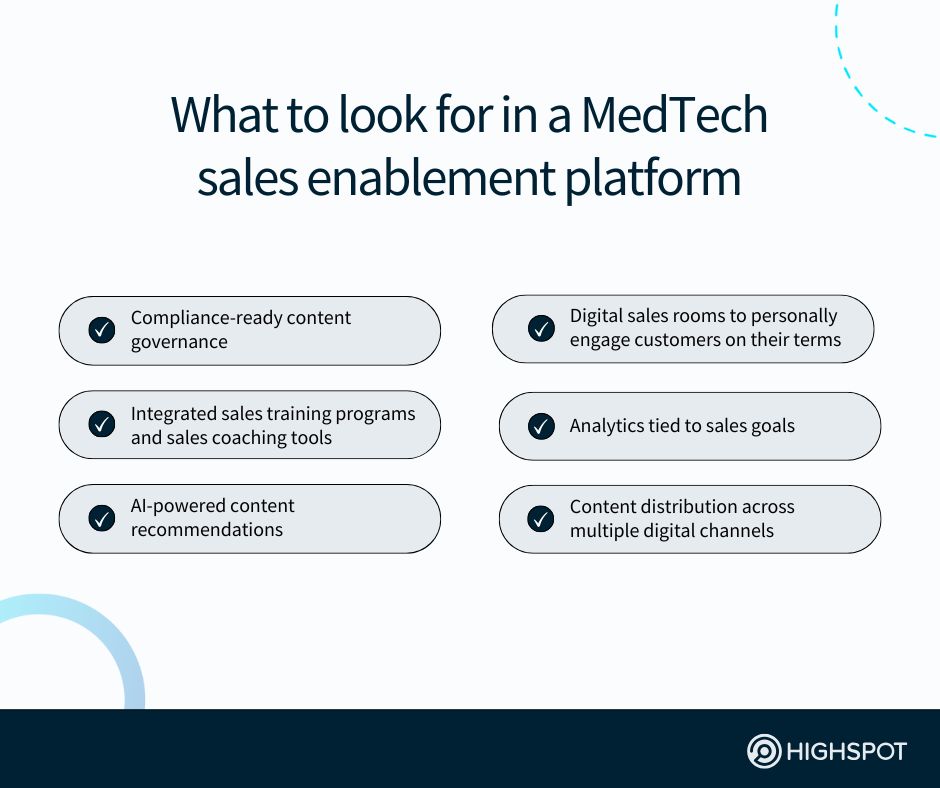Key takeaways
- MedTech buyers expect consumer-like experiences with consistent engagement across all channels, including email, video, chat, and digital sales rooms.
- Many HCPs now prefer virtual or hybrid sales engagement. You need the right tools to meet customers where they are.
- You can rely on AI-powered technology to tailor outreach and guide next steps, as you move leads from discovery to closed-won.
Technology buying behaviors are changing fast, and we see it every day.
Healthcare providers (HCPs), health system procurement leaders, and hospital decision-makers, who once relied almost entirely on in-person sales calls and paper materials, now expect the same ease of access and personalization they experience with everyday consumer tech across a mix of remote channels.
If you’ve ever struggled to get the attention of hospital and health system procurement offices, wondering if your emails are getting lost in their inbox, you’re not alone. Selling in MedTech is complex—and it’s only getting more so.
The good news? Using a go-to-market (GTM) performance platform with advanced AI and robust analytics can help MedTech sales teams connect with buyers where they are and help them deliver the right sales content at the right time.
What MedTech buyers at healthcare organizations really want
Today’s MedTech buyers, including physicians, hospital committees, and clinical support staff, want speed, personalization, and value when interacting with you. More to the point, they want info on their preferred channels and in a format that’s easily consumable (and doesn’t waste their time).
Since most healthcare professionals also have limited time and prefer either completely virtual or hybrid meetings, you need to align your engagement strategy to match.
Every touchpoint, whether in-person interactions, video calls, or digital sales rooms, must feel like a unified customer journey with equally valuable info across all channels.
The key to omnichannel sales success is high-quality customer data.
Only with timely, complete, and compliant data can you and your team accurately predict behaviors, understand preferences, and—in turn—personalize buying experiences.
With this data—and the right GTM enablement solution integrated into your data stack—you can build stronger customer relationships, improve customer satisfaction, and enhance engagement across every interaction.
The rise in omnichannel engagement at MedTech companies
Seller-buyer interactions used to follow a fixed path.
Many companies standardized each stage to a specific channel. First contact was made by phone, followed by a sales follow-up email, an online demo, maybe an in-person proof of concept, and a final phone call or email to close the deal.
Regardless of preference, every buyer was steered through the same journey, essentially.
Today, that approach simply doesn’t work. Every new lead interacts differently. One might start with an email and then follow up with a text. Another might join a virtual demo, then ping you through a digital sales room while reviewing materials with their internal team.
The shift to relying on a variety of channels didn’t happen overnight. It accelerated with the rise of consumer digital habits, remote work, and AI-powered sales tools that enable buyers to research products and services and reach out on their own terms.
You can’t expect healthcare professionals—physicians, administrators, buying committees, and IT leaders—to wait until a future scheduled call to get an answer to an immediate question. They want in-the-moment responses on the channel they choose.
That’s why consistent, intelligent responses must be available across all channels.
It’s not enough to personalize your texts if your emails sound scripted. And trust will be broken if there is a misalignment in messaging:
- Imagine you’re discussing pricing and close dates with a late-stage lead.
- Then, the buyer receives a marketing email titled, “Discover the 5 Early Signs You’re Ready for a New MedTech Partner” from your organization.
- Your marketing team has no idea their counterparts in sales are already nearing the end of the sales cycle with the prospect in question.
- These communication and data disconnects make it clear your GTM teams aren’t aligned.
To stay ahead, your MedTech firm must move beyond a rep-led model and deliver smooth, helpful experiences across every customer interaction: from live calls, SMS, and email, to content hubs, online chat, digital sales rooms, and any other channel they use.
To modernize your sales approach, though, you need to know where your process needs to be changed—and that means understanding your omnichannel sales readiness level.
Omnichannel maturity curve
Here’s what the engagement progression looks like from rep-led to fully integrated omnichannel.
Ask yourself: Where does your organization fall on the maturity curve? And what steps can you take to develop a more cohesive communications approach across all channels your buyers use?
The answers will reveal how your GTM should evolve your sales strategy.
Perhaps you need to better integrate data-driven analytics to understand content usage. Or, maybe adopting an AI enablement platform is what you need to personalize buying experiences.
| Stage | Description | Key features |
|---|---|---|
| Rep-led | – Traditional model – Reps are the primary touchpoint – Limited digital presence | – Rep-focused – Infrequent digital follow-up – Siloed content |
| Hybrid engagement | – Mix of in-person and digital interactions – Basic personalization and CRM tools | – Email, content hubs – Virtual demos – Basic analytics – Some rep enablement |
| Integrated omnichannel | – Unified experience across all touchpoints – AI-driven, personalized, compliant, and scalable | – AI suggestions – Consistent messaging – Real-time analytics and governance |
Equipping your medical sales reps with the right tools
Healthcare, in general, has been slow to adopt digital tools. However, the pace is picking up.
Many MedTech executives now view emerging digital technologies, including predictive data analytics, AI/ML, and cloud computing, as strategic priorities for their companies.
Like many other industries, many MedTech manufacturers and suppliers had limited remote selling infrastructure before 2020. But, as selling shifted heavily online, digital healthcare enablement tools supporting the new buying patterns across all channels became mainstream.
As a MedTech leader, you can now prepare your sales force with capabilities like AI-powered content recommendations, analytics tied to sales goals, guided selling, and digital sales rooms to deliver personalized experiences with content, track content engagement, and respond to real‑time behaviors.
This keeps the sales process flowing and helps both sides of the buying equation: Prospects feel understood, and your sales reps get better customer insights to steer conversations and follow-ups.
Leverage content data and leading sales AI for personalized engagement
Personalized engagement means you and your team need to know what the buyer wants before they even ask.
Artificial intelligence helps by using data to tailor messages to each customer’s preferences, clinical focus, or past behaviors. Many tools analyze CRM data, email responses, and content usage to detect patterns and suggest the ‘next best action.’
Start by reviewing the customer data you already have, such as what content customers are clicking on:
- When are your leads most responsive to your messaging?
- What type of customer feedback is in your CRM notes or emails?
- How often do prospects engage with sales collateral you share?
Then, layer in AI to spot patterns you might miss or analyze large amounts of data. Build your personalization around these buyer insights, and you’ll be in a better position than making assumptions.
As Harmony Johnston-Grant of Medtronic emphasized in a recent episode of Highspot’s Win Win Podcast, in regulated industries like MedTech, how AI is used matters just as much as what it does.
“What’s really crucial is that AI and technology are underpinned by trust,” Johnston-Grant explained.
This means it’s crucial to use customer data in an ethical, compliant way and factor non-technical risks into your AI strategy from the start to ensure omnichannel sales success.
Optimize and scale content delivery without compromising compliance
Content is fundamental to any MedTech customer engagement strategy. In this industry, though, it must be truthful, evidence-based, and compliant. That’s why content often gets stuck in lengthy legal reviews.
Structured content governance is the foundation of any high-performing MedTech sales strategy.
A centralized content library with version control, workflow automation, and robust security and data privacy controls allow you to get high-value content to market faster without violating policy.
One common mistake is to market software features for use cases that haven’t been FDA-cleared, such as saying your platform helps diagnose conditions when it’s only approved for workflow support. These off-label claims can trigger regulatory scrutiny and weaken trust and longer-term customer loyalty.
Start your content journey with commonly used materials, like product datasheets, reimbursement guides, and peer-reviewed studies. Then, onboarding an enablement platform that tracks approval dates, audit trails, and has role-based access, so only the latest, compliant content is available for use.
(For more content regulation information, see the FDA’s latest guidance on digital content.)
Prioritize training and AI-powered coaching for your sales reps
Your MedTech sales reps obviously need to know your product specs, regulatory limits, and industry processes, given that selling into healthcare is more consultative than typical B2B sales.
Buyers need continuous accuracy in everything you provide to trust your business and offerings.
Ongoing sales enablement training and certification ensure sales reps stay current and sharp. But coaching matters, too. The good news is you can take advantage of AI-powered solutions like Highspot to analyze recorded calls, identify skill gaps, and give real-time feedback.
Whether it’s tone, talk track, or objection handling, AI sales training and coaching in our GTM performance platform can help your MedTech sales managers support their reps individually.

Embracing the future of MedTech buyer engagement
The MedTech industry is at a crossroads.
As customer expectations rise and competition heats up, companies that modernize their engagement strategies will win. On the flip side, those that stick to old rep-led tactics will struggle to keep up.
Remember that the customer behavior of any B2B buyer, including key decision-makers at healthcare organizations, is often unpredictable, fluid, and channel-agnostic—just like the consumer world.
That’s why enabling your sales reps, marketers, and other customer-facing team members to engage with leads on the right channel at the right moment with the right content is key to long-term success, in terms of both net-new customer acquisition and loyalty.




